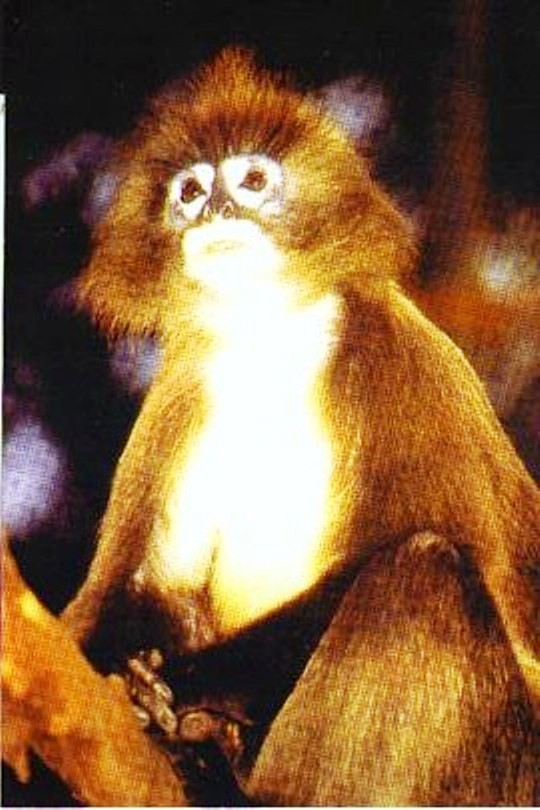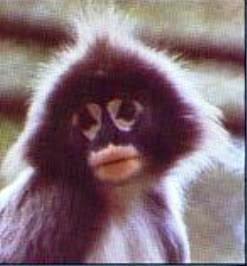|
ANIMALS: MALMATA
The common wild mammalia at
present on the wane due to economic development and urbanaisation are elephant,
bison, deer, leopard, jackal, monkey, cat, pig, dog, etc. By far the most
valuable wild life of the state is the elephant which are sometimes seen in
herds in the forests of the Kalajhari Hill range, the Raimasarma valley, the
catchment area of the Manu river. Often they cause havoc in the remote villages
in the hill areas, particularly in the harvesting season. In the
elephant-infested area, the Tripuris sometimes have to protect themselves from
rogue elephants by some makeshift arrangement in the treetops which serve as
their temporary abode.
There were tigers, rhinos, yaks,
bears, hyenas, and many others innumerable beasts roaming in the jungles of
Tripura. The royal Bengal tiger was
once found plenty in the deep forests Tripura, even some 40-60 years ago, as narrated by
many elders, senior people, and grand parents. These would even come to
residential area to attack the domestic animals and some time human life. There were ample of examples of
person being killed by tigers, to be true, in every village, at least some
person or else had been attacked by tigers.
Elephant attacking human
settlement are still at large in Tripura, large numbers of such incidents are
occurring every year. The tigers could be easily killed by mixing poison in
carcasses, but the elephant, which is vegetarian, would not be killed. Apart
from that governmental prohibition, its mighty power deterred to be killed
easily by poachers.
 There are numerous kind of
monkeys found in Tripura, some are in danger of extinction. One special kind of
monkey found only in Tripura is Spectacle Monkey or 'Chosma Mwkhwra' as locally
known. It has a distinct spectacle shape of white tuft hair encircling its eyes,
which makes it looks like monkey wearing a spectacle, so the name applied to it. There are numerous kind of
monkeys found in Tripura, some are in danger of extinction. One special kind of
monkey found only in Tripura is Spectacle Monkey or 'Chosma Mwkhwra' as locally
known. It has a distinct spectacle shape of white tuft hair encircling its eyes,
which makes it looks like monkey wearing a spectacle, so the name applied to it.
Besides these there used to be
different types of snakes, poisonous and non poisonous. There are many mythology
and folktales full of snakes and pythons. There were some oral historical facts
coming down since generations, which says that once there was such a big python
which attempted to prey an large adult elephant. the python tried to kill the
elephant by coiling it, when it took support of large bamboo bunches, which got
cracked and cut the python instead, as a result the python died itself, and
elephant could escape, other wise it would had been swallowed, by the mighty
python.
Apart from python, there were
numerous poisonous snakes, which are locally known as, namely-king cobra,
black cobra, white cobra etc. Other than these there were used to be rattled
snake, banded kraite, any many more whose a droplet of poison would killed lots
of people in the past.
The type of deer generally seen
in the state is the Barking Deer (curvulus muntjac) or Khata Harm. Small- sized
and reddish brown in colour, they come out of the forests for grazing during the
time of jhooming, when the forests are burnt. In the southern plains of the
State, viz., in Sonamura, Bilonia and Subrum sub-divisions are found the wild
boar (sus cristatus). They are a favourite hunt in hey day old time for Tripuri
people by and large.
FISHES
The dominant form of life in all
the water covering most populacc of the earth is the fishes, the largest class
of vertebrates, There is hardly a lake, stream, river or pond which not contain
some kind of fish. The rivers flow into the river Meghna in Bangladesh, and this
has somehow reduced the scope of availability of river fishes in the State.
However, during monsoon (June-August) when the rivers swell enormously and
inundate the adjoining low-lying areas, certain fishes, viz cartelagenous and
larged sized cat fishes migrate from major rivers of Bangladesh into territory.
Fishes related to the group cytariophysi, viz., carps, catfishes and loaches are
also commonly found in almost all rivers. Small in size but bright and silvery
in colour, some of their species like chela, katari, chapkhori (or chapila),
etc., are popular among the common people for their taste and moderate price.
The major carps of the subfamily cyprininac belonging to the species katla, rui,
katibaush, ghania, bhagna, mrigal, etc., are also raised by the households in
their own ponds and tanks. Smaller varieties of the same origin like sarputi,
puti, etc., and different varieties of pabda (silvery white fish) belonging to
the Siluridae family are also found in abundance in jheels, tanks and rivers.
These fishes are quite tasty and nutritious, and are often a good source of
income. 'Aristocrats' among them are rui, katla and pabda.
Other fishes having their common
habitat in shallow waters and small streams found throughout the State are
tangra, gulasha, aeer, bojori, all belonging to the family Bagridae; singh or
singhee of the family saccobranchidae, kakya (or kai), chanda, the only species
representing, respectively, the families of xenentodontidae and centroponzidae.
Most of these fishes make excellent dishes and are liked much by the people.
The state's large marshy and
water areas offer ample scope for a good crop of closed-water fishes every year.
The State's fishery department has taken steps in this direction. Training
facilities are offered to the actual pisciculturists in technical aspects and
material assistance is extended for induced breeding of high-yielding varieties
of crops. The production of fish has exceeded 21,000 metric tons in 1990-91 from
12,000 in 1986-87. The Gomati reservoir is exploited for pisciculture by members
of fishermen's to-operative societies which include the Tripuris of the
adjoining areas. The marketing of fish collected from the reservoir is done
through five permanent fish stalls established in five major towns of the state.
For pisciculture emphasis was so
long given to the development of fisheries in valleys only; at present steps are
also taken to develop fisheries in the hilly areas as well by constructing
mini-barrages across hilly enclaves and bringing the same under improved
culture. Apart from developing new water areas for increasing fish production,
the Government seems to have made sincere attempts to ensure that the fruits of
fishery development schemes benefit the fishermen, and with that end in view
water areas are now leased out at Government approved rates to persons belonging
to the fishermen community and Tripuris.
The Perching Birds
Considered as the most advanced
group of birds, they account for more than one-half of all modem avian species.
An important distinguishing feature is their keen sense of organs, a highly
efficient nervous system and a high rate of body activity that produces the
highest body temperature found in the animal kingdom. Small to medium sized, and
feet adopted for holding onto branches, most of these birds have a
well-developed voice apparatus and are distinguished by their songs and calls.
 The most important species of
perching birds found in Tripura are: the jungle crow or Dora kak (c.
Macrorhynchus), red bulbul (Pycnonotus cafer and jocosus), green bulbul (c.
aurifrous), king crow or pechya (Dicrurus adsimilis), house sparrow (Passer
dontesticus) Indian Tree Pie (Dendrocitta vagabunda) or taroka, common babbler (Turdoides
caudatus) or chilchil. Also found in the same group are Jerdon's chlorpsis, a
grass going bird of an approximate size of a bulbul, the song birds shama
having almost the same size as that of a bulbu, with a bit long tail, magpie
robin, or doyel and the tailorbird (Orthotomus sutorius) or tuntuni, as it is
popularly known, the crop-raiding baya weaver bird (Ploceus philippinus) or
babui which move about in flocks and the blackheaded oriole or haldi pakhi, etc.
Babui birds are of the size of a sparrow with its upper parts streaked heavily
with dark brown and the breast with yellow colour. The haldi pakhis are of the
size of a mynah and are sometimes found near human habitations. It is quite
interesting to see the making of a nest by the green-coloured little tuntuni
with a few pieces of leaves and grass. Like any other bird's nests, their
attempts in building a nest display a fine workmanship; it is indeed remarkable
in view of the fact that the birds have only their beak and legs to serve as
tools. The forests in the vicinity of Rudrasagar lake are the nesting grounds of
a variety of birds. The most important species of
perching birds found in Tripura are: the jungle crow or Dora kak (c.
Macrorhynchus), red bulbul (Pycnonotus cafer and jocosus), green bulbul (c.
aurifrous), king crow or pechya (Dicrurus adsimilis), house sparrow (Passer
dontesticus) Indian Tree Pie (Dendrocitta vagabunda) or taroka, common babbler (Turdoides
caudatus) or chilchil. Also found in the same group are Jerdon's chlorpsis, a
grass going bird of an approximate size of a bulbul, the song birds shama
having almost the same size as that of a bulbu, with a bit long tail, magpie
robin, or doyel and the tailorbird (Orthotomus sutorius) or tuntuni, as it is
popularly known, the crop-raiding baya weaver bird (Ploceus philippinus) or
babui which move about in flocks and the blackheaded oriole or haldi pakhi, etc.
Babui birds are of the size of a sparrow with its upper parts streaked heavily
with dark brown and the breast with yellow colour. The haldi pakhis are of the
size of a mynah and are sometimes found near human habitations. It is quite
interesting to see the making of a nest by the green-coloured little tuntuni
with a few pieces of leaves and grass. Like any other bird's nests, their
attempts in building a nest display a fine workmanship; it is indeed remarkable
in view of the fact that the birds have only their beak and legs to serve as
tools. The forests in the vicinity of Rudrasagar lake are the nesting grounds of
a variety of birds.
Noted for their beauty, colour
and variety and some for their call or song are tuntuni, bulbul, mynah or mama,
haldi pakhi, slim but long-tailed bhating. glossy steel coloured and
sparrow-sized migratory species of swallow (Hirundo rustica) or balia and munia.
During the summer months, one hears the songs of the Indian cuckoo (Cuculus
micropternus), popularly known as Fantok Chakhwi. In Rudrasagar bed of Sonamura
sub-division is seen pancowri, a cormorant-like water bird of the size of a
kite. Its colour is black with silvery streaks on the back and soft brown head
and neck and whitish chin and throat. With a long and pointed bill, slender and
snake-like neck, the bird feeds on fish, crabs, frogs, etc.
The other avian fauna of Tripura
include jungle fowl, owl, kite, parrot, kingfisher, woodpecker. vultures,
flower- picker, duck, pigeon, etc. Besides myriads of protozoans, there arc
spongilla, coelenterates, helminth-parasites, butterflies, locusts, scorpions,
centipedes, millipedes, musseh, slugs and snails.
|